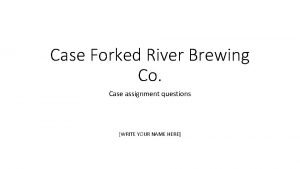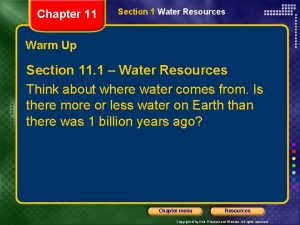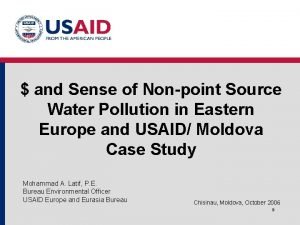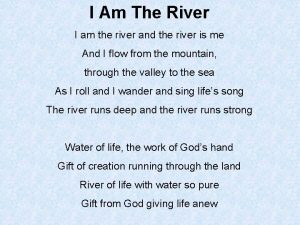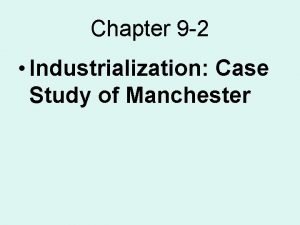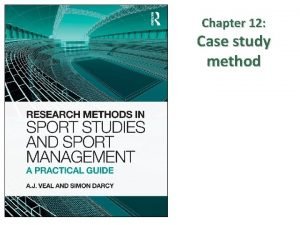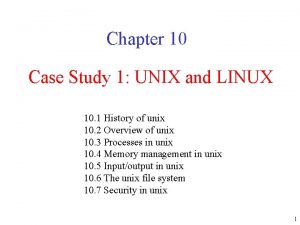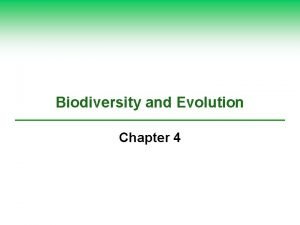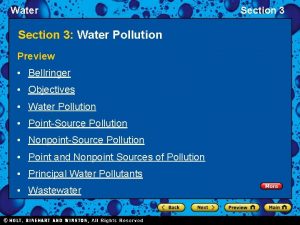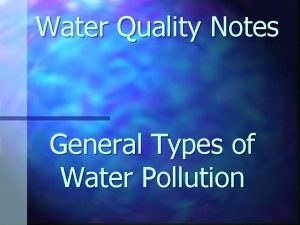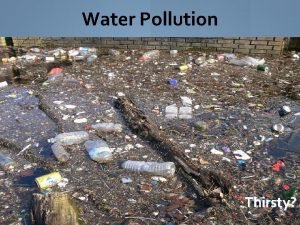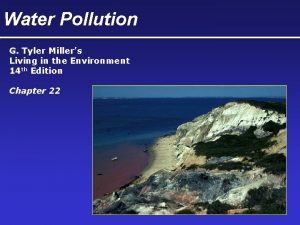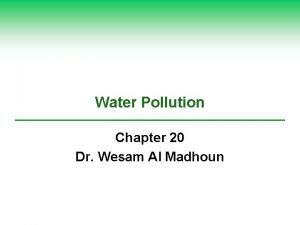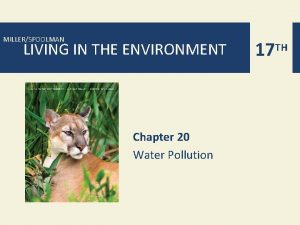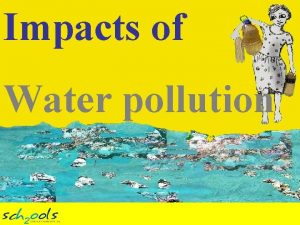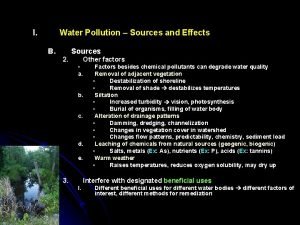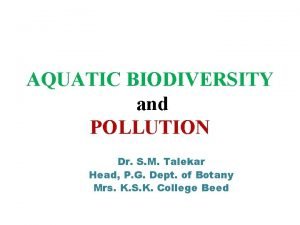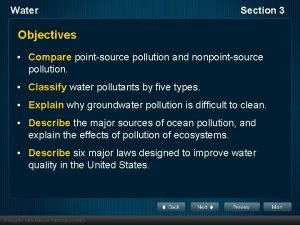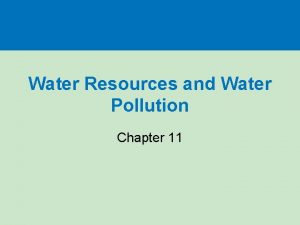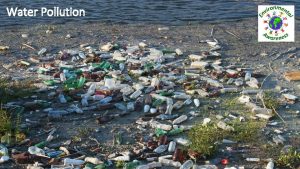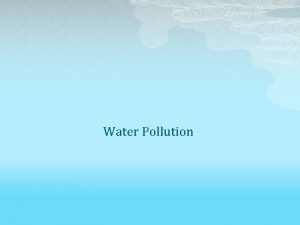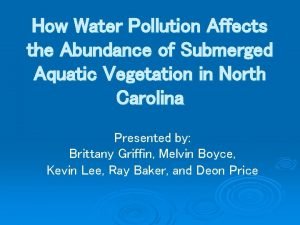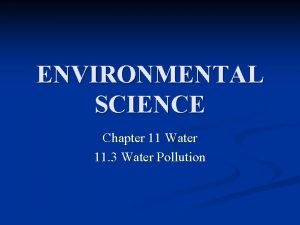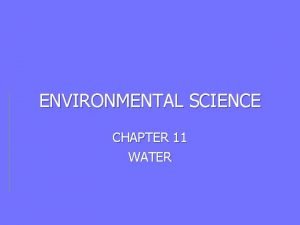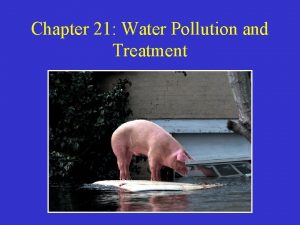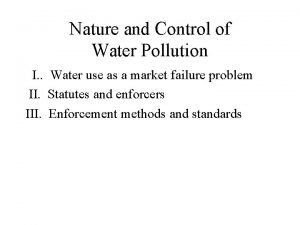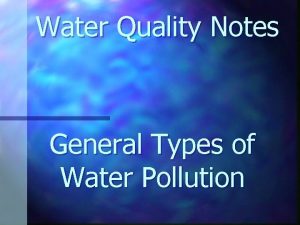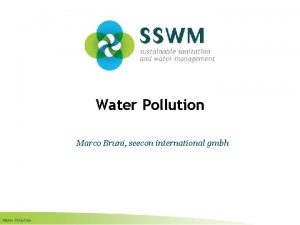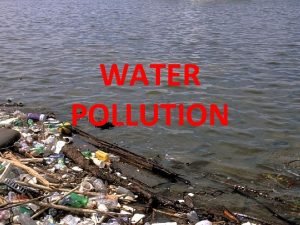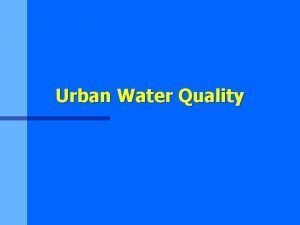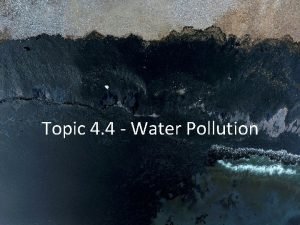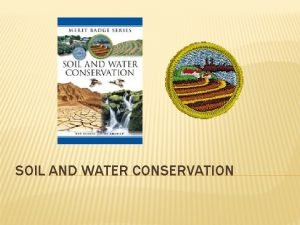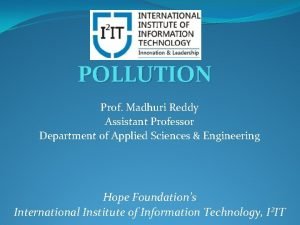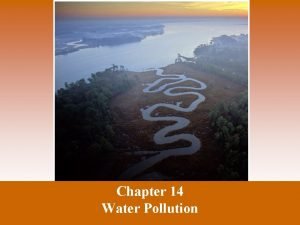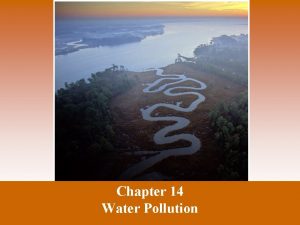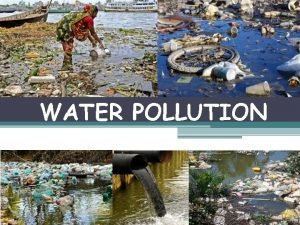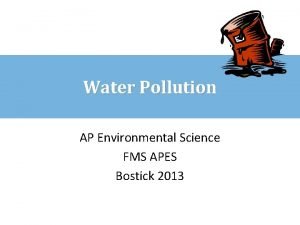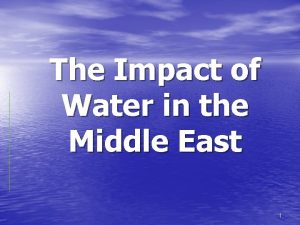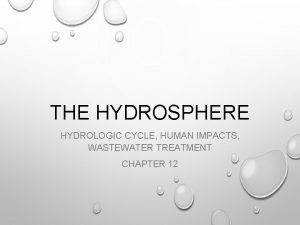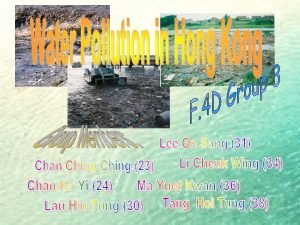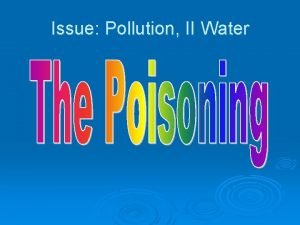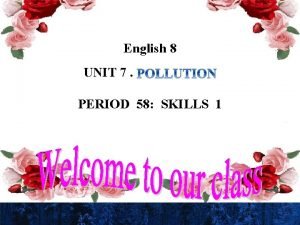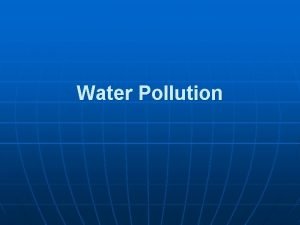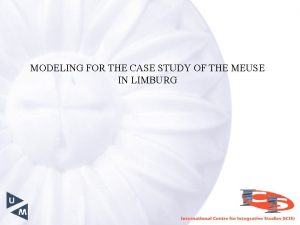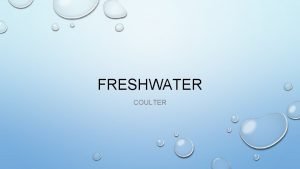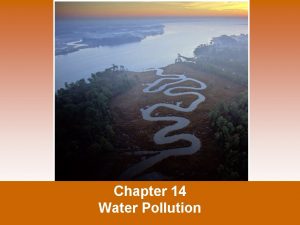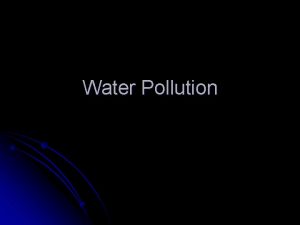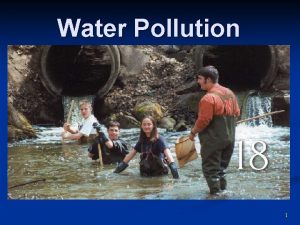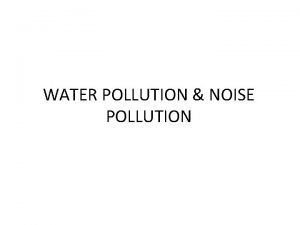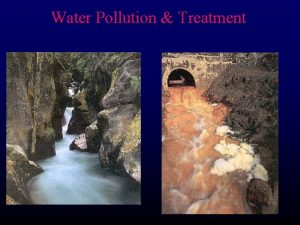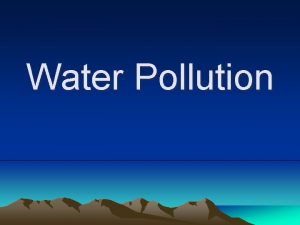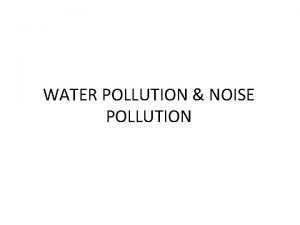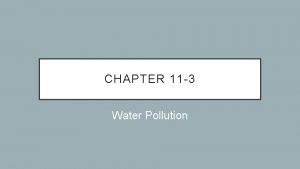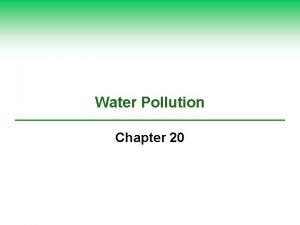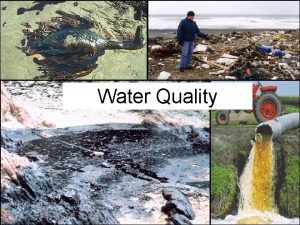Water Pollution Chapter 20 Case Study A River
















































































- Slides: 80

Water Pollution Chapter 20

Case Study: A River on Fire § § Cuyahoga River Cleveland, Ohio 1969 Spurred Amendment to Clean Water Act

Water Pollution Comes from Point and Nonpoint Sources § Water pollution is any chemical, biological, or physical change in water quality that harms living organisms or makes water unsuitable for desired uses. § Underlying causes are industrialization and rapid human population growth. § Water pollution comes from two types of sources: • point sources • nonpoint sources

Point Source Pollution § Point-source pollution is pollution that comes from a specific site. § Examples: a factory, a wastewater treatment plant, or a leaking oil tanker § Can often be identified and traced to a source

Point Source Pollution

Point Source of Polluted Water in Gargas, France

Nonpoint Source Pollution § Non-point source pollution is pollution that comes from many sources rather than from a single specific site. § Example: pollution that reaches a body of water from streets and storm sewers. § Cannot be traced back to a single source

Nonpoint Source Pollution

Nonpoint Sediment from Unprotected Farmland Flows into Streams

Water Pollution Comes from Point and Nonpoint Sources § Agriculture activities: leading cause of water pollution • Sediment eroded from the lands • Fertilizers and pesticides • Bacteria from livestock § Industrial facilities • Second major source of water pollution • Organic and inorganic chemicals § Mining • Erosion of sediments • Runoff of toxic chemicals

Water Pollution Comes from Point and Nonpoint Sources § Other sources of water pollution • Parking lots • Human-made materials • E. g. , plastics


Major Water Pollutants Have Harmful Effects § Infectious disease organisms: contaminated drinking water § The World Health Organization (WHO) • 3 Million people die every year, mostly under the age of 5

Major Water Pollutants and Their Sources

Common Diseases Transmitted to Humans through Contaminated Drinking Water

Science Focus: Testing Water for Pollutants (1) § Variety of tests to determine water quality: § Coliform bacteria: Escherichia coli, significant levels § Level of dissolved oxygen (DO) § Chemical analysis determines presence of organic chemicals

DO Seasonal Variation: DO & Temp Inverse Relationship



Science Focus: Testing Water for Pollutants (2) § Indicator species • Examples: cattails, stoneflies, mollusks § Bacteria and yeast glow in the presence of a particular toxic chemical § Color and turbidity (cloudiness) of the water • Sediment, algae

Secchi Disk

Secchi Disk

Secchi Disk

Water Quality as Measured by Dissolved Oxygen Content in Parts per Million

Streams Can Cleanse Themselves If We Do Not Overload Them § Dilution § Biodegradation of wastes by bacteria takes time § Oxygen sag curve • Due to breakdown of biodegradable wastes by bacteria • BOD

Dilution and Decay of Degradable, Oxygen-Demanding Wastes in a Stream

Stream Pollution in Developed Countries § 1970 s: Water pollution control laws § Successful water clean-up stories • Ohio Cuyahoga River, U. S. • Thames River, Great Britain § Accidental/Deliberate contamination of toxic inorganic and organic chemicals by industries and mines

Global Outlook: Stream Pollution in Developing Countries § Half of the world’s 500 rivers are polluted § Untreated sewage & Industrial waste § India’s rivers § China’s rivers

Girl Sits on the Edge of a Road beside a Stream Loaded with Raw Sewage in Iraq

Natural Capital Degradation: Highly Polluted River in China

Trash Truck Disposing of Garbage into a River in Peru

Case Study: India’s Ganges River: Religion, Poverty, Population Growth, and Health (1) § Holy river: religious customs § Sewage § Human remains § Government intervention • Waste treatment plants • Crematoriums

Low Water Flow and Too Little Mixing Makes Lakes Vulnerable to Water Pollution § More vulnerable than streams § Less effective at diluting pollutants than streams • Stratified layers • Little vertical mixing • Little of no water flow

Cultural Eutrophication Is Too Much of a Good Thing (1) § Eutrophication – nutrient enrichment § Oligotrophic lake • Low nutrients, clear water § Cultural eutrophication - accelerates the input of nutrients into a body of water

Natural Eutrophication

Algae/Cyanobacteria

Duckweed

Water Hyacinth – Invasive Species

The Great Lakes of North America

Water pollution § Developed countries have made great strides in cleaning up many polluted water supplies • Some water is still dangerously polluted. • Lake Erie:

Water pollution

Round Goby

Ground Water Cannot Cleanse Itself Very Well (1) § Source of drinking water § Common pollutants • Fertilizers and pesticides • Gasoline • Organic solvents § Pollutants dispersed in a widening plume

Ground Water Cannot Cleanse Itself Very Well (2) § Slower chemical reactions in groundwater due to • Slow flow: contaminants not diluted • Less dissolved oxygen • Fewer decomposing bacteria

Principal Sources of Groundwater Contamination in the U. S.

Groundwater Contamination from a Leaking Gasoline Tank

Groundwater Pollution Is a Serious Threat § China: many contaminated or overexploited aquifers § U. S. : FDA reports of toxins found in many aquifers § What about leaking underground storage tanks: • Gasoline, Oil • Methyl tertiary butyl ether (MTBE) • Nitrate ions

Case Study: A Natural Threat from Arsenic in Groundwater § Source of As in the groundwater – rock and soil § Human health hazards: cancer • Skin • Lungs • Bladder

Pollution Prevention Is the Only Effective Way to Protect Groundwater § Prevent contamination of groundwater • Least expensive • Most effective way to protect groundwater § Cleanup: expensive and time consuming

Solutions: Groundwater Pollution, Prevention and Cleanup

There Are Many Ways to Purify Drinking Water § § § Reservoirs and purification plants Process sewer water to drinking water Expose clear plastic containers to sunlight (UV) Nanofilters The Life. Straw

Lifestraw

Case Study: Protecting Watersheds Instead of Building Water Purification Plants § New York City water • Reservoirs in the Catskill Mountains § Protect the watershed instead of water purification plants

Is Bottled Water the Answer? § U. S. : some of the cleanest drinking water § Bottled water • • Some from tap water 40% bacterial contamination Fuel cost to manufacture the plastic bottles Recycling of the plastic § Growing back-to-the-tap movement

Biodegradable Algae Water Bottle

Edible Cutlery

Ocean Pollution Is a Growing and Poorly Understood Problem (1) § 2006: State of the Marine Environment • 80% of marine pollution originates on land • Sewage • Coastal areas most affected § Deeper ocean waters • Dilution • Dispersion • Degradation


Great Pacific Garbage Patch

Ocean Pollution Is a Growing and Poorly Understood Problem (2) § Cruise line pollution: what is being dumped? § U. S. coastal waters • • Raw sewage Sewage and agricultural runoff Harmful algal blooms Oxygen-depleted zones

Dead Zones

Dead Zones

Residential Areas, Factories, and Farms Contribute to Pollution of Coastal Waters

A Red Tide § Harmful algal blooms § Release waterborne and airborne toxins § Fish kills § Human respiratory problems

Ocean Oil Pollution Is a Serious Problem (1) § Crude and refined petroleum • Highly disruptive pollutants § Largest source of ocean oil pollution • Urban and industrial runoff from land § 1989: Exxon Valdez, oil tanker • Oil Pollution Act 1990 • Oil tankers must be double hulled


BP Deep-water Horizon (2010)

BP & Exxon Valdez compared

Solutions: Coastal Water Pollution, Prevention and Cleanup

We Need to Reduce Surface Water Pollution from Nonpoint Sources (1) § Discussion: How do we do this?

Sewage Treatment Reduces Water Pollution (1) § Wastewater or sewage treatment plants • Primary sewage treatment • Physical process • Secondary sewage treatment • Biological process • Tertiary or advance sewage treatment • Chemical process (Bleaching, chlorination) • Removal of excess Nitrogen & Phosphorus

Sewage Treatment Reduces Water Pollution § Quaternary Treatment – Reverse Osmosis • Decrease pollutants including antibiotics, pesticides and hormones using reverse osmosis • REALLY expensive and just starting up

Solutions: Septic Tank System

Solutions: Primary and Secondary Sewage Treatment

CSO – Combined Sewage Overflow

We Can Improve Conventional Sewage Treatment § Peter Montague: environmental scientist • Remove toxic wastes before water goes to the municipal sewage treatment plants • Use composting toilet systems § Wetland-based sewage treatment systems

Solutions: Ecological Wastewater Purification by a Living Machine, RI, U. S.

Solutions: Water Pollution, Methods for Preventing and Reducing Water Pollution

What Can You Do? Water Pollution, Ways to Help Reduce Water Pollution

Drinking Water Treatment
 Water and water and water water
Water and water and water water River eden case study
River eden case study Forked river brewing company swot analysis
Forked river brewing company swot analysis Best case worst case average case
Best case worst case average case Hershey's erp failure
Hershey's erp failure Introduction about water pollution
Introduction about water pollution Chapter 11 section 3 water pollution
Chapter 11 section 3 water pollution Observation of river pollution
Observation of river pollution Tukwila
Tukwila I am the river and the river is me
I am the river and the river is me Industrialization case study manchester answer key
Industrialization case study manchester answer key Chapter 12 case study
Chapter 12 case study Chapter 10 case study
Chapter 10 case study Case study chapter 4
Case study chapter 4 Groundwater pollution
Groundwater pollution Section 3 water pollution
Section 3 water pollution Type of reefs
Type of reefs Water pollution solutions
Water pollution solutions What are the terrible twelve water pollution
What are the terrible twelve water pollution Solutions to water pollution
Solutions to water pollution 2 causes of soil pollution
2 causes of soil pollution 8 effects of water pollution
8 effects of water pollution Soil pollution images diagram
Soil pollution images diagram Methods of water pollution
Methods of water pollution Effects of water pollution
Effects of water pollution Ddt water pollution
Ddt water pollution What are 5 effects of water pollution?
What are 5 effects of water pollution? Aims and objectives of water pollution
Aims and objectives of water pollution How we can reduce water pollution
How we can reduce water pollution Conclusion of water pollution
Conclusion of water pollution Types of water pollution
Types of water pollution Why is water pollution a great concern in southwest asia
Why is water pollution a great concern in southwest asia Summary of water pollution
Summary of water pollution Wastewater sludge
Wastewater sludge Environmental science chapter 11
Environmental science chapter 11 Thermal pollution
Thermal pollution Introduction of water pollution
Introduction of water pollution Site:slidetodoc.com
Site:slidetodoc.com Nasa space shuttle
Nasa space shuttle Pollution of water is responsible for
Pollution of water is responsible for Water pollution conclusion
Water pollution conclusion Water pollution
Water pollution A variety
A variety Soil conservation project
Soil conservation project Water pollution information
Water pollution information Water pollution
Water pollution Sakuna remove pollution
Sakuna remove pollution Chapter 11 section 1 water resources
Chapter 11 section 1 water resources Industrial waste causes
Industrial waste causes Anaerobic methane digester frq
Anaerobic methane digester frq Middle east
Middle east Conclusion of water pollution
Conclusion of water pollution Water pollution in hong kong
Water pollution in hong kong What is water pollution?
What is water pollution? Water pollution theory
Water pollution theory Water pollution conclusion
Water pollution conclusion Unit 7 english 8
Unit 7 english 8 N
N Why is water pollution of great concern in southwest asia
Why is water pollution of great concern in southwest asia Class 8 english chapter 7 water water everywhere
Class 8 english chapter 7 water water everywhere River meuse case
River meuse case Blood on the river novel study
Blood on the river novel study The land area that supplies water to a river system
The land area that supplies water to a river system Dub denman canoe trail
Dub denman canoe trail San joaquin river exchange contractors
San joaquin river exchange contractors This water sport is done on rough river waters. *
This water sport is done on rough river waters. * Chapter 12 section 1 what causes air pollution answers
Chapter 12 section 1 what causes air pollution answers Chapter 12 air section 1 what causes air pollution
Chapter 12 air section 1 what causes air pollution Long case and short case
Long case and short case Binary search time complexity worst case
Binary search time complexity worst case Case western reserve university case school of engineering
Case western reserve university case school of engineering Bubble sort algorithm pseudocode
Bubble sort algorithm pseudocode Bubble sort best case and worst case
Bubble sort best case and worst case Bubble sort best case and worst case
Bubble sort best case and worst case Triangle ambiguous case
Triangle ambiguous case Chapter 9 surface water chapter assessment answer key
Chapter 9 surface water chapter assessment answer key Mis zara
Mis zara Yelp case study analysis
Yelp case study analysis Kf memory case study
Kf memory case study Beth anders
Beth anders Action research vs case study
Action research vs case study


